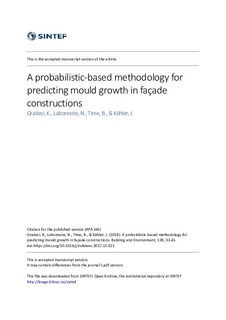| dc.contributor.author | Gradeci, Klodian | |
| dc.contributor.author | Labonnote, Nathalie | |
| dc.contributor.author | Time, Berit | |
| dc.contributor.author | Kohler, Jochen | |
| dc.date.accessioned | 2018-07-18T10:45:32Z | |
| dc.date.available | 2018-07-18T10:45:32Z | |
| dc.date.created | 2017-11-27T10:17:36Z | |
| dc.date.issued | 2017 | |
| dc.identifier.citation | Building and Environment. 2017, 128 33-45. | nb_NO |
| dc.identifier.issn | 0360-1323 | |
| dc.identifier.uri | http://hdl.handle.net/11250/2505995 | |
| dc.description.abstract | Predicting mould growth on façade constructions during design is important for preventing financial loss, and ensuring a healthy and comfortable indoor environment. Uncertainties in predicting mould growth are related to the representation of the biological phenomenon, the climate exposure and the material uncertainties. This paper proposes a probabilistic-based methodology that assesses the performance of façade constructions against mould growth and accounts for the aforementioned uncertainties. A comprehensive representation of mould growth is ensured by integrating several mould models in a combined outcome. This approach enables a more comprehensible and useful illustration between continuous mould growth intensities and their corresponding likelihoods. The outdoor climate exposure is represented by stochastic models derived by real time-series analysis according to autoregressive–moving-average models. The methodology is applied to investigate the influence of several parameters and the performance of several construction assemblies. This paper proposes a method to evaluate the façade performance that can facilitate reliability-based design and optimisation of façade construction. | nb_NO |
| dc.description.sponsorship | The work was supported by TallFaçades project that is funded by the Research Council of Norway under the fourth joint call of the European WoodWisdomNet research programme. | nb_NO |
| dc.language.iso | eng | nb_NO |
| dc.publisher | Elsevier | nb_NO |
| dc.rights | Attribution-NonCommercial-NoDerivatives 4.0 Internasjonal | * |
| dc.rights | Attribution-NonCommercial-NoDerivatives 4.0 Internasjonal | * |
| dc.rights.uri | http://creativecommons.org/licenses/by-nc-nd/4.0/deed.no | * |
| dc.subject | Mould | nb_NO |
| dc.subject | Probabilistic analysis | nb_NO |
| dc.subject | Autoregressive-moving average model | nb_NO |
| dc.subject | Sensitivity analysis | nb_NO |
| dc.subject | Uncertainty | nb_NO |
| dc.subject | Timber | nb_NO |
| dc.title | A probabilistic-based methodology for predicting mould growth in façade constructions | nb_NO |
| dc.type | Journal article | nb_NO |
| dc.type | Peer reviewed | nb_NO |
| dc.description.version | acceptedVersion | nb_NO |
| dc.rights.holder | © 2018 Elsevier B.V. All rights reserved. This is the authors' accepted and refereed manuscript to the article. Released with a Creative Commons Attribution Non-Commercial No Derivatives License. The final publication is available at https://doi.org/10.1016/j.buildenv.2017.11.021 | nb_NO |
| dc.subject.nsi | VDP::Teknologi: 500 | nb_NO |
| dc.source.pagenumber | 33-45 | nb_NO |
| dc.source.volume | 128 | nb_NO |
| dc.source.journal | Building and Environment | nb_NO |
| dc.identifier.doi | 10.1016/j.buildenv.2017.11.021 | |
| dc.identifier.cristin | 1518686 | |
| dc.relation.project | Norges forskningsråd: 237139 | nb_NO |
| cristin.unitcode | 7401,30,40,0 | |
| cristin.unitname | Arkitektur, byggematerialer og konstruksjoner | |
| cristin.ispublished | true | |
| cristin.fulltext | postprint | |
| cristin.qualitycode | 2 | |

